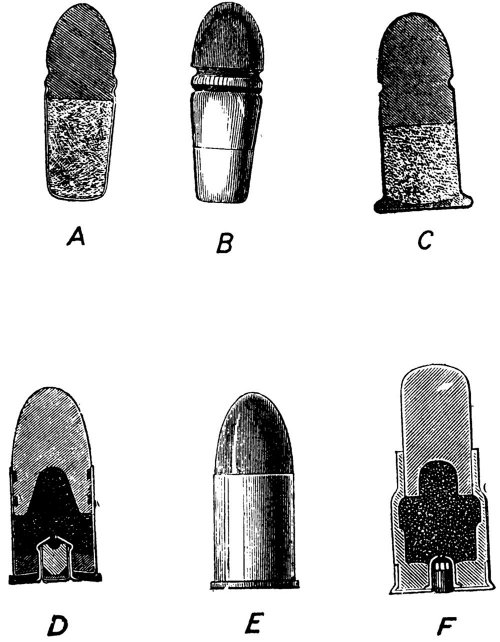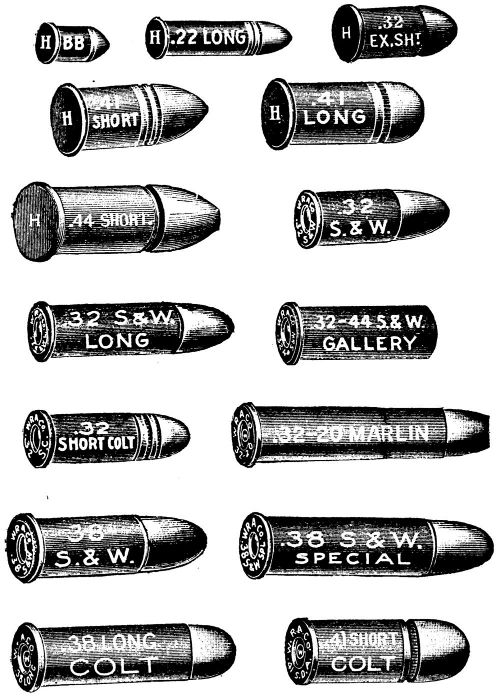The following information on pistol and revolver ammunition comes from The Book of the Pistol and Revolver by Hugh B. C. Pollard. The Book of the Pistol and Revolver is also available to purchase in print.
The development of sound ammunition has to a large extent been the reason for the production of modern pistols. The one has reacted upon the other, and where in some cases weapons were designed to fit special cartridges, in modern practice special cartridges are designed for improved pistols.
The modern ammunition maker’s catalogue is a mine of detailed information about powder charges, bullet weights, initial muzzle velocities with different barrel lengths, average muzzle energies, and standards of penetration; and little more than a brief survey of popular pistol cartridges and their historical development can be given in these pages.

For more detailed knowledge the reader is recommended to refer to the catalogue of Kynochs, Eleys, The Winchester Fire Arms Co., The Union Metallic Cartridge Co., or any first-class ammunition firm. In cases where very special information is required the expert departments of these firms are usually exceedingly courteous in replying to inquiries, but it is hard to find any point not already covered in their annual catalogues. Modern cartridges are evolved by a process of calculation and experiment in which the weight of the weapon, the calibre, the maximum weight of bullet, and the length of barrel, are all taken into consideration.
The best powder charge having been found, different scales of powder charge adapted to various bullets, such as special flat-nosed target types and special hollow-nosed hunting bullets, require similar variations from the standard load.
Nowadays all modern pistol and revolver ammunition is made for smokeless powder, and a specially hardened or nickel-based or nickel-covered bullet is used, but the practice of giving the powder charge in terms of “grains of black powder” is still in use, as black powder forms a good normal standard of comparison.
In actual practice a charge of smokeless “equivalent to so many grains of black” is used, though in some automatic and modern military charges the load is given as “grains of cordite or dense smokeless powder.”
To revert to the history of the cartridge, one must remember the development of the device, on the principle of embodying the percussion-cap with the charge to facilitate effective breech loading.
The muzzle-loading cartridges were either a spherical or conical ball, behind which was tied a small conical goldbeater’s-skin bag containing the powder charge. This skin was varnished to exclude damp, and the whole was wrapped in a tough cartridge paper case from which projected a tape. Pulling this tape ripped open the paper envelope and exposed the fragile charge, which was rammed down the barrel or chamber, and in some cases further wadded home by ramming down the paper cartridge case on top. The nipple was then capped, or, in the case of flintlocks, the flash-pan “primed” with a small charge of fine powder.
Most muzzle-loading pistols were not used with cartridges but simply loaded with a charge, of powder out of a self-measuring powder-flask, wadded down with a paper or linen patch or wad followed by a bullet wrapped in a patch, or if tight fitting forced down by means of a mallet. In some cases a top wad was used to prevent the bullet rolling loose out of the barrel or not resting tight upon the powder charge.
Muzzle-loading revolvers were used with factory-made ammunition of skin cartridges, although sent out direct from the makers, complete with bullet-mould.
Some English makers issued revolvers for use either with the ordinary loose load or “Daws Copper Cartridge,” which consisted of a copper thimble holding a powder charge. The breech end of this was covered by a thin blue paper wad, while the bullet end had a central circular hole 1/8-inch wide in it; this fitted over a small neck or stud cast on the base of the bullet, which was swaged over inside the copper thimble in order to carry it with it. The principle was not satisfactory, as there was a tendency for the copper thimble less its base to remain wedged in the chamber, preventing reloading till it had been scraped out. Muzzle loading was in general vogue until after 1860-1865, by which time breech loading in various forms of cartridge was taking precedence in popularity.
The needle-gun cartridge (1842), with a cap at the base of the bullet and exploded by a needle striker that penetrated the whole length of the powder charge, was one of the first types of cartridge. The shell was made of self-consuming linen or paper, and burnt and blew out with the charge. The gas escape at the breech made this system dangerous and unpleasant, but pistols for this cartridge—the Farington in 1865 and the Nestler of 1867—have been evolved.
Europe was behindhand with her official adoption of the metallic breech-loading cartridge, which, although invented in the shape of the Flobert pin-fire and the Lefaucheux pin-fire in 1851 and embodied by Lancaster in a metallic centre-fire cartridge in 1852, did not obtain recognition till many years later, or rather till the genius of American arms companies and private gunsmiths of all nationalities had produced it to such a state of efficiency that the “official” weapons and ammunition systems were hopelessly obsolete. The prevailing military fashions in needle-guns were probably responsible, but the earlier all-metal central and rim-fire cartridges were by no means as well made or as cheap as their descendants of the late nineties and the twentieth century. Specimens of early pistol cartridges in the author’s collection show a wonderful crudity of manufacture—ill-fitting caps and cap-washers, clumsy bullets and swage marks on the brass case, all combining with a thick and clumsy rim to produce a cartridge of dubious efficiency, prone to jam from “proud cap” (i.e., the cap blowing out or back on to the striker) and difficult to extract when fixed.
The rim-fire bulleted breech-cap of .22 calibre soon evolved into the .22 short, .25, .300, .320 long and short, .350, .410 short and long, .442—the latter the first official revolver cartridge used in the Enfield revolver as an arm for the British Service, and a variety of long .44 calibre cartridges for Remington, Colt, Frank-Wesson, Forehand and Wadsworth, Marlin, and other American pistols and revolvers. The .410 rimfire short is to this day the favourite cartridge for Derringer pistols; and the modern .22 cartridge, in all its variations and lengths, charges and special adaptions, is evolved from the original and still popular No. 1 bulleted breech-cap shown by Flobert over fifty years ago.
The rim-fire principle was simple, and consisted in spinning a copper alloy shell with a wide-flanged hollow rim. This rim and the base of the shell was charged with fulminate, which detonated when pinched between the face of the breech and the pin or striker of the hammer. Rim-fire cartridges cannot be reloaded, and are less certain in their actions than centre-fire. A point against them is, that in process of time the continual fall of the hammer causes a depression in the face of the breech-block into which the cartridge is forced by the striker, but without detonating. Rim-fire weapons should never be “clicked” on an empty chamber. They possessed an advantage over the pin-fire device in that they could be put into the chamber any way up, and were adaptable for repeating mechanisms. Rimfire revolvers were common after 1870.
The pin-fire of Lefaucheux cartridge was, and is still, popular in France, Belgium, and on the Continent generally, and numerous cheap revolvers to take this ammunition are annually turned out. It has not changed from its original form, and is still made in .6, .7, .9, and .12 mm. The principle is simple. At the base of a rimless cylindrical cartridge-shell is set a thick wad, recessed to receive a small cap set vertically to receive a brass pin that projects externally and at right angles to the line of the chamber. These pins project beyond the cylinder, and receive the blow of the flat-nosed hammer which drives them into the cap exploding the charge.

All these systems have given place to the modern central-fire “all-metallic” cartridge-case, which, when properly made and loaded, is practically certain in action, invariable in effect, waterproof, and not likely to deteriorate much from storage. Very small matters—such as the effect of hot climates on the charge, minute variations in the load of the cap, swedging or crimping the shell or case on to the bullet, and similar points—make a wide difference for target work, but do not much affect the efficiency of the load for ordinary purposes.
By 1870 the central-fire cartridge-case for pistols and revolvers was in use, and by ten years later it was universal in all but cheap weapons and the .22 and .410 calibres. In the centre-fire cartridge the shell is drawn with a recessed base, in which is formed a perforated dome depressed toward the interior of the shell. Into this recess is forced from outside a cap containing a charge of fulminate and a small metal stamping called the “anvil.” This abuts upon the dome, but leaves a clear space for the flame produced by the explosion, when the cap is crushed upon the anvil by the striker, to pass, and penetrating through the hole in the dome, fire the charge. Different makers have different shaped caps and anvils, and in America, where the cap is called a “primer,” the anvil and cap are often self-contained, a process which simplifies amateur reloading. The modern central- fire cartridge-case is easily reloaded, but this is a practice seldom indulged in in this country. In the U.S.A., on the other hand, many people reload their own cartridges, cast their own bullets, and prepare their own ammunition. Broadly speaking, the waste of time is not worth the small saving in money, but for those who are interested in experimental loads, or who make a hobby of the loading, complete reloading outfits, powder measures, swages, moulds, etc., can be bought in the shape of most ingenious tools from the “Ideal” Company, but it is only fair to add that hand-loading very seldom approaches the all-round excellence and reliability of ordinary factory-loaded ammunition.
English cartridges differ from American in having the bullet and shell of the same external diameter, the heel, or portion of the bullet within the case, being reduced to admit of the sizing. Such cartridges are the .320, the .380, and .450; in each case the final “0” differentiates them from the American .32, .38, etc. In the American sizes the cartridge-shell is of greater diameter than the bullet, and the chamber is more acutely shouldered, the section admitting the shell being of greater bore than that taking the bullet. This principle is far better, as it prevents the bullet being deformed at that portion of its base most needed to prevent the escape of powder-gas past it, and most modern English revolvers are made for the American or S. and W. cartridges. In all modern central-fire revolver ammunition lubrication plays a large part, and the grease for this purpose is held in recessed rings, or cannelures, round the base of the bullet inside the cartridge-case. This, in all smokeless powder ammunition, is tightly crimped on to the bullet, in order to retain it sufficiently to insure its not creeping out of the case from the recoil of neighbouring chambers or commencing its travel before combustion of the smokeless charge (which needs a certain amount of confinement) is properly commenced.
